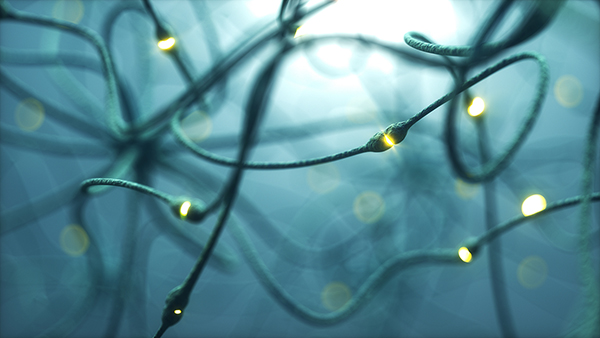



| By Ami Brannon

Vagal stimulation for mood and pain relief has been on my radar screen for several years now. I’m excited to see innovative companies developing consumer devices to harness this technology for self-care. I was skeptical at first, but after I synced some of my favorite music—Audioslave—with the Neuvana wave form, I fell into a sort of meditative state, and enjoyed the music with a deep appreciation of the textures of sound. It felt peaceful, relaxing, focusing and energizing. There’s lots of research on the benefits of vagal stimulation for relaxation, pain relief, even depression. The Xen enables consumers to access those in an easy-to-use home device. I think I’ll end up using it for a periodic recharge while doing tedious work—a 15 minute session a couple of times a day should enhance my output.
—Dr. Hoffman
This article contains content from one of our trusted sponsors.
Our nervous systems are equipped with automatic systems that help us respond to threats or perceived danger, and then recover when the coast is clear. The sympathetic nervous system (“fight or flight”) kicks in when your brain senses danger. Your body automatically ramps up with elevated heart rate, fast breathing, dilated pupils, and digestion is paused so you can “escape the tiger.” When you make it to safety, your brain activates the parasympathetic nervous system by releasing calming neurotransmitters like acetylcholine, serotonin, and GABA. Your breathing and heart rate slow down, pupils constrict, and digestion starts again.
The majority of the body’s parasympathetic response relies on the activation of the vagus nerve for optimal function. Touted as the information superhighway between the brain and the body, the vagus nerve is the longest cranial nerve we have. Originating from the brainstem as a pair of nerves and converging as a single “cable”, the vagus nerve extends to every major organ in the body.
In the mid-20th century, scientists and clinicians discovered a connection between the vagus nerve and different portions of the brain. After years of research and a number of clinical trials, more is now understood about how the vagus nerve contributes to communication between the brain and the organ systems of the body. Evidence shows that vagus nerve stimulation (VNS), can have a significant impact on general health and a variety of disorders. VNS can be delivered through either an implanted surgical device or through the skin (transcutaneous).
tVNS (transcutaneous VNS) sends electrical stimulation through the surface of the skin. This is generally applied via the left ear (taVNS) but may also be done on the neck. tVNS is applied by the user and does not require surgery or other procedures.
taVNS has been shown to be a safe and effective method of neurostimulation, as evidenced by a growing body of studies on healthy subjects, as well as those battling chronic conditions.
Today, scientists are focusing even more on the benefits of taVNS and its potential to maintain a healthy balance in the nervous system and mitigate the effects of chronic conditions.
It’s rare to come across a tiger that might chase you. However, today’s continuous ping of emails, texts, DMs, news headlines, and questions from your confused children often take on a wildcat persona. It seems our brains are assaulted with a continuous stream of stressful inputs and we have little time to recover before the next crisis. This manifests itself as chronic stress. You likely already know that unmanaged chronic stress can lead to:
So, where does vagus nerve stimulation come into play?
The resilience necessary to keep your nervous system in balance requires a “toned vagus nerve.” People have used a variety of techniques to regularly stimulate the vagus nerve in an effort to make it more resilient/toned. Some techniques include meditation, yoga, chanting, and patterned breathing, all of which are indirect and take time and practice to achieve. taVNS, on the other hand, provides direct electrical stimulation to a branch of the vagus nerve located in the ear. This form of stimulation is convenient, simple, and does not require practice to achieve the benefits.
The next time you feel like a tiger is chasing you, grab your portable taVNS unit to relax, recharge and prepare for the next …
For more information, visit Neuvana.
References:
Ben-Menachem, E. European Journal of Neurology, vol. 7, no. 6, 2000, doi:10.1111/j.1468-1331.2000.00005.x.
Bretherton, Beatrice, et al. “Effects of Transcutaneous Vagus Nerve Stimulation in Individuals Aged 55 Years or above: Potential Benefits of Daily Stimulation.” Aging, vol. 11, no. 14, 2019, pp. 4836–4857., doi:10.18632/aging.102074.
Butt, Mohsin F., et al. “The Anatomical Basis for Transcutaneous Auricular Vagus Nerve Stimulation.” Journal of Anatomy, vol. 236, no. 4, 2020, pp. 588–611., doi:10.1111/joa.13122.
Frangos, Eleni, et al. “Non-Invasive Access to the Vagus Nerve Central Projections via Electrical Stimulation of the External Ear: FMRI Evidence in Humans.” Brain Stimulation, vol. 8, no. 3, 2015, pp. 624–636., doi:10.1016/j.brs.2014.11.018.
Though we think of declining estrogen as the hallmark of menopause, it's actually common for…

Up to 12 percent of Americans have ulcers at some point in life. Peptic ulcers…
Gallbladder disease is a modern illness. An estimated 20 million Americans have gallbladder disease. The…

There’s more to GI health than whether or not to take an acid-blocker. All too…

In the latest attempt to remove “stigma” from medical terminology, liver specialists have come up…

Q: My husband’s high sensitivity C-reactive protein (hs-CRP) is 1.62 and his homocysteine is 13.1. If…

Banish the Bloat: Leyla Weighs In with Tips and Insights

Our virtual voicemail is open 24/7, so there's no need to wait to submit your questions for Dr. Hoffman. Leave a message, and you may hear your question featured on the Intelligent Medicine radio program!